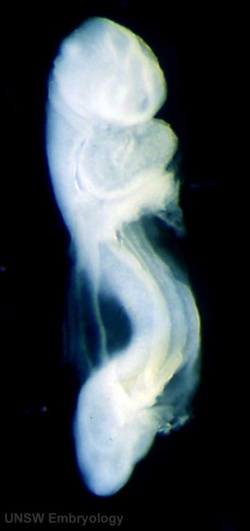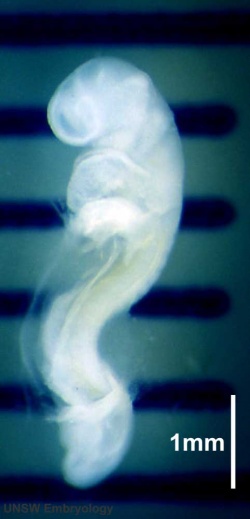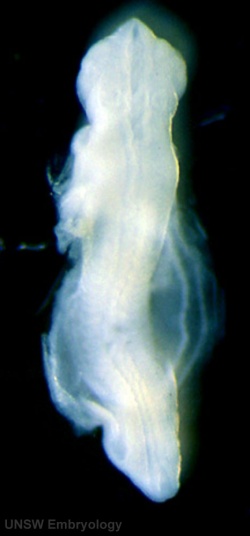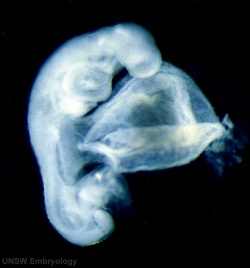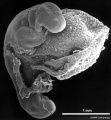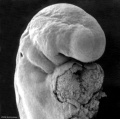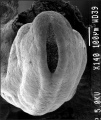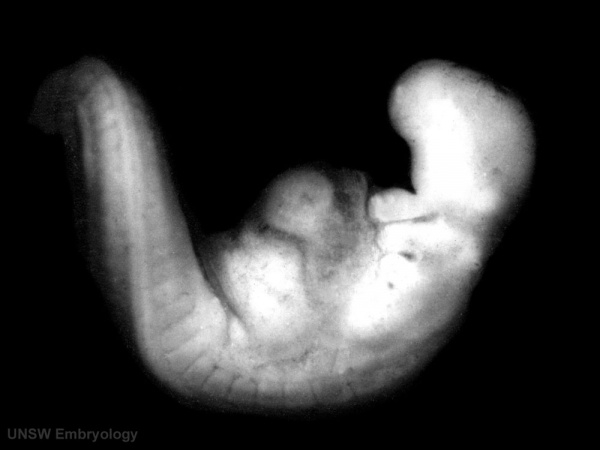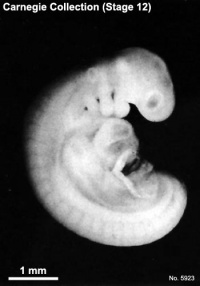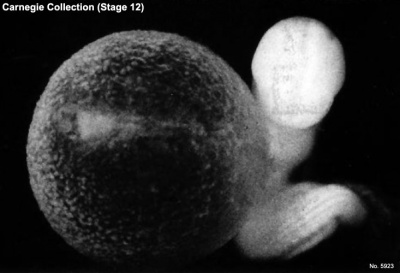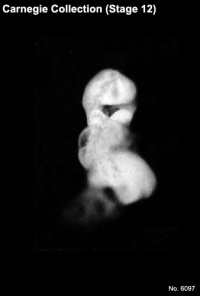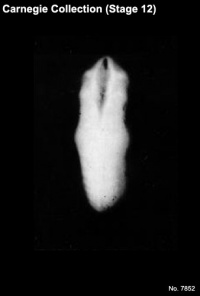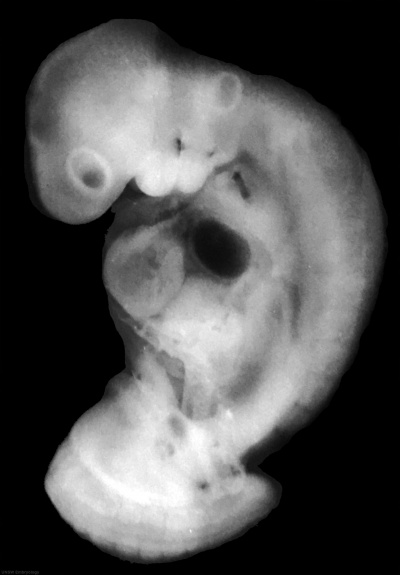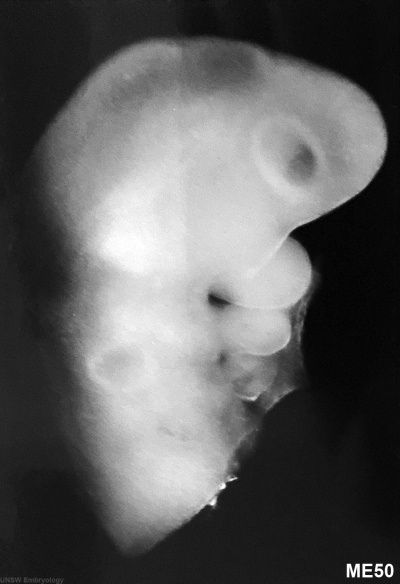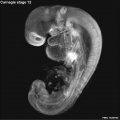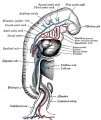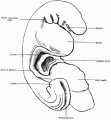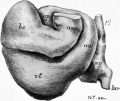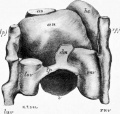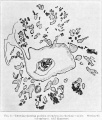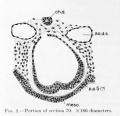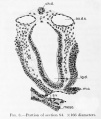Carnegie stage 12
| Embryology - 27 Apr 2024 |
|---|
| Google Translate - select your language from the list shown below (this will open a new external page) |
|
العربية | català | 中文 | 中國傳統的 | français | Deutsche | עִברִית | हिंदी | bahasa Indonesia | italiano | 日本語 | 한국어 | မြန်မာ | Pilipino | Polskie | português | ਪੰਜਾਬੀ ਦੇ | Română | русский | Español | Swahili | Svensk | ไทย | Türkçe | اردو | ייִדיש | Tiếng Việt These external translations are automated and may not be accurate. (More? About Translations) |
Introduction

|
FactsWeek 4, 26 - 30 days, 3 - 5 mm, Somite Number 21 - 29
Summary
Features
|
| Week: | 1 | 2 | 3 | 4 | 5 | 6 | 7 | 8 |
| Carnegie stage: | 1 2 3 4 | 5 6 | 7 8 9 | 10 11 12 13 | 14 15 | 16 17 | 18 19 | 20 21 22 23 |
- Carnegie Stages: 1 | 2 | 3 | 4 | 5 | 6 | 7 | 8 | 9 | 10 | 11 | 12 | 13 | 14 | 15 | 16 | 17 | 18 | 19 | 20 | 21 | 22 | 23 | About Stages | Timeline
Bright Field
Scanning EM
Image Source: Scanning electron micrographs of the Carnegie stages of the early human embryos are reproduced with the permission of Prof Kathy Sulik, from embryos collected by Dr. Vekemans and Tania Attié-Bitach. Images are for educational purposes only and cannot be reproduced electronically or in writing without permission.
Kyoto Collection
View: Lateral view, day 26, 27 somites, Amniotic membrane removed.
Image source: The Kyoto Collection images are reproduced with the permission of Prof. Kohei Shiota and Prof. Shigehito Yamada, Anatomy and Developmental Biology, Kyoto University Graduate School of Medicine, Kyoto, Japan for educational purposes only and cannot be reproduced electronically or in writing without permission.
Carnegie Collection
- Carnegie Stages: 1 | 2 | 3 | 4 | 5 | 6 | 7 | 8 | 9 | 10 | 11 | 12 | 13 | 14 | 15 | 16 | 17 | 18 | 19 | 20 | 21 | 22 | 23 | About Stages | Timeline
| Carnegie Collection Embryos - Stage 12 | ||||||||||
|---|---|---|---|---|---|---|---|---|---|---|
| Serial No. | Pairs of somites | Size (mm) | Grade | Fixative | Embedding Medium | Plane | Thinness (µm) | Stain | Year | Notes |
| 209 | ca_24 | EH3 Ch.,15 | Poor | Alc | P | Coronal | 50 | Al. coch. | 1902 | |
| 250 | 19? | E , 2 (11, 10x9x9 | Poor | p | ? | Sagittal | 20 | Al. coch. | p | |
| 384 | P | E 2_5 Ch.,13 | Poor | Formalin | P | Transverse | 10 | H.&E. | 1907 | Macerated. Narrow yolk stalk |
| 486 | 21 | E.,4 Ch., 22 | Good | Corros. acetic | P | Transverse | 10 | Al. Coch. | 1911 | |
| 1062 | 29 | E.,4.5 Ch., 20 | Good | Formalin | P | Transverse | 20 | Al. coch. | 1915 | Transitional to next stage |
| 2197 | ? | E_,5_3 Ch., 19.5 | Poor | Formalin | P | Transverse | 10 | Al. coch, or. G. | 1918 | |
| 4245-7 | ca.24 | E.,3.5 Ch., 24 | Good | Alc, formol | P | Transverse | 10 | Al. coch. | 1923 | Caudal neuropore widely open |
| 4479 | P | E.,5 .8 Ch , 17 | Poor | Formalin | P | Transverse | 40 | Al. coch. | 1923 | Macerated. Upper lirnb buds not visible |
| 4736 | 26 | E.,3.0 Ch.,20 | Good | Formalin | P | Coronal | 10 | Al. coch. | 1924 | No upper limb buds. Caudal neuropore closed |
| 4759 | ? | E.,4.5 Ch.,15 | Good | Formalin | P | Transverse | 15 | (Stain - Haematoxylin Eosin) | 1924 | Neural tube folded |
| 4784 | 23 | E_,3 | Good | P | P | Transverse | 10 | p | 1924 | |
| 5035 | 25-28 | E.,3.8 Ch.,18 | Good | Formalin | C-P | Transverse | 10 | Al. coch. | 1925 | |
| 5048 | ca_25 | E_,3_5 | Good | Formalin | C-P | Transverse | 10 | Al. coch. | 1925 | Tubal Injured |
| 5056 | 25 | E,,3 Ch.,12 | Good | Formalin | P | Transverse | 10 | Al. coch. | 1925 | |
| 5206 | ? | E.,4 Ch., 51x31x30 | Poor | ?? | P | Transverse | 20 | Al. coch. | 1926 | Tubal |
| 5300 | ? | E., 4.5 Ch,16.5 | Poor | Formalin | P | Transverse | 20 | Al. coch. | 1926 | Autopsy. Partly macerated |
| 5923 | 28 | E.,4 Ch.,15 | Exc. | Formalin | P | Transverse | 10 | Al. coch. | 1929 | |
| 6097 | 25 | E,3.4 Ch., 12.5 | Exc. | Formalin | C-P | Transverse | 10 | Al. coch, eosin | 1930 | Tubal Ag added to slides 1-3 |
| 6144 | 27 | E. 3.3 Ch.,11 | Good | Lysol—Zenker | C—P | Transverse | 10 | Al. coch. | 1930 | |
| 6488 | 28 | E, 32 Ch,22 | Good | Formalin | C—P | Transverse | 10 | Al. coch. | 1932 | |
| 6937 | 26 | E.,3 Ch , 12 | Poor | Formalin | C—P | Coronal | 10 | I.H.,or.G. | 1934 | Tubal Caudal neuropore closed |
| 7724 | ca.29 | E,3.5 Ch.,18 | Good | Formalin | C—P | Sagittal | 8 | (Stain - Haematoxylin Eosin) | 1940 | Caudal end broken |
| 7852 | 25 | E , 3.7 Ch,26 | Exc. | Formalin | C—P | Transverse | 10 | (Stain - Haematoxylin Eosin) | 1940 | Typical for stage 12 |
| 7999 | ca.28 | E,3.2 Ch , 15 | Exc. | Bouin | C-P | Transverse | 10 | (Stain - Haematoxylin Eosin) | 1942 | Caudal defect |
| 8505a | 24 | Ch, 23.5 | Exc. | Formalin | C-P | Transverse | P | H. Phlox. | 1947 | |
| 8505b | 23 | Ch,24 | Exc. | Formalin | C-P | Sagittal | p | Azan | 1947 | Twins |
| 8941 | 28 | E,4.9 Ch, 35 | Exc. | Zenker | C-P | Transverse | 6 I.H. | 1927 | Univ. Chicago No. H 1261 | |
| 8942 | 25 | E, 38 Ch, 35 | Exc. | Formal-Zenker | C-P | Coronal | 5 11-1. | 1930 | Univ. Chicago No. H 1382 | |
| 8943 | 22 | E. 3.9 Ch, 20.4 | Exc. | Formal-Zenker | C-P | Transverse | 8 | H.&E. | 1934 | Univ. Chicago No. H 1481 |
| 8944 | 25 | E,4 Ch,,25 | Exc. | Formal-Zenker | C-P | Sagittal | 8 | I.H. | 1936 | Univ. Chicago No. H 1514 |
| 8963 | 22 | E, 3.8 Ch , 14.5 | Fair | Formalin | C-P | Transverse | 10 | I.H. | 1928 | Univ. Chicago. No. H 1093 Studied by Wen (1928)[1] |
| 8964 | 23 | E,2.8 Ch - 25 | Poor | Formalin | p | Transverse | 8 | I.H. | 1928 | Univ_ Chicago No. H984 Studied by Wen (1928)[1] |
| 9154 | 24 | E, 5 4 | Exc | Formalin | C-P | Transverse | I.H. & phlox. | 1953 | ||
Abbreviations
| ||||||||||
References
| ||||||||||
| iBook - Carnegie Embryos | |
|---|---|
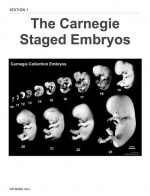
|
|
Hill Collection
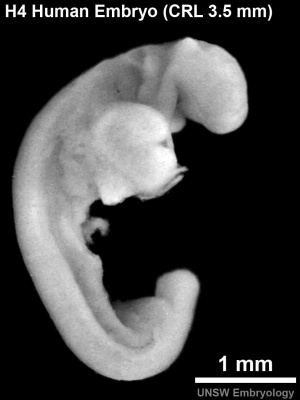
|
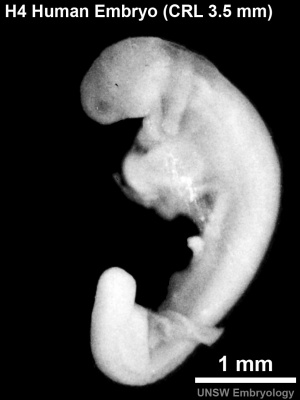
|
| right view | left view |
- Links: Hill Collection
Hinrichsen Collection
Hinrichsen collection Human Embryo ME50 (stage12).
Note the developing pharyngeal arches, otic and optic placodes, and heart in this left lateral view of the embryo.
Image source: The Hinrichsen Collection images are reproduced with the permission of Prof. Beate Brand-Saberi, Head, Department of Anatomy and Molecular Embryology, Ruhr-Universität Bochum. Images are for educational purposes only and cannot be reproduced electronically or in writing without permission.
Historic Embryology
Chicago Collection H1093 and H984
H1093 and H984 are University of Chicago Collection 22 and 23 somite embryos respectively, described by Wen (1928)[1] - The anatomy of human embryos with seventeen to twenty-three pairs of somites..
Events
- somitogenesis - stages 12 and 13 embryo somite 1 has dispersed and is now contributing to the hypoglossal cord. Therefore “in embryos with more than 20 somites” (beginning of stage 12), the first ones visible “actually are second somites”.[2]
- neural - caudal neuroprkoe closes.[3]
- hearing - otic vesicle (otocyst) is forming and connects by a narrow pore with the surface[4] Otocyst ventral wall contributes to the vestibulocochlear crest.
- meninges - (spinal cord) - a great advance has occurred in the migration of cells about the neural tube, as well as a further increase in the size of the neural crests (spinal ganglia). The ventrally migrating neural crest cells are still quite clearly distinct from the somites. This may indicate that the tissues immediately adjacent to the periphery of the neural tube originate from the neural crest. It is in this group that vascularization of the tissue surrounding the neural tube begins.[5]
- genital - primordial germ cells are located within the wall of the hindgut.[6]
References
- ↑ Wen IC. The anatomy of human embryos with seventeen to twenty-three pairs of somites (1928) J. Comp. Neural., 45: 301-376.
- ↑ Arey LB. The history of the first somite in human embryos. (1938) Contrib. Embryol., Carnegie Inst. Wash. Publ. 496, 27: 233-269.
- ↑ Müller F. and O'Rahilly R. The development of the human brain, the closure of the caudal neuropore, and the beginning of secondary neurulation at stage 12. (1987) Anat Embryol (Berl). 176(4): 413-430. PMID 3688450
- ↑ Streeter GL. Developmental horizons in human embryos. Description of age group XI, 13 to 20 somites, and age group XII, 21 to 29 somites. (1942) Contrib. Embryol., Carnegie Inst. Wash. Publ. 541, 30: 211-245.
- ↑ Sensenig EC. The early development of the meninges of the spinal cord in human embryos. (1951) Contrib. Embryol., Carnegie Inst. Wash. Publ. 611.
- ↑ Witschi E. Migration of the germ cells of human embryos from the yolk sac to the primitive gonadal folds. (1948) Carnegie Instn. Wash. Publ. 575, Contrib. Embryol., 32: 67-80.
Thompson P. Description of a human embryo of twenty-three paired somites. (1907) J Anat Physiol, 41(3):159-71. PMID 17232726
Sgalitzer KE. Contribution to the study of the morphogenesis of the thyroid gland. (1941) J Anat. 75(4): 389-405. PMID 17104869
Additional Images
Historic Images
| Historic Disclaimer - information about historic embryology pages |
|---|
| Pages where the terms "Historic" (textbooks, papers, people, recommendations) appear on this site, and sections within pages where this disclaimer appears, indicate that the content and scientific understanding are specific to the time of publication. This means that while some scientific descriptions are still accurate, the terminology and interpretation of the developmental mechanisms reflect the understanding at the time of original publication and those of the preceding periods, these terms, interpretations and recommendations may not reflect our current scientific understanding. (More? Embryology History | Historic Embryology Papers) |
Thompson P. Description of a human embryo of twenty-three paired somites. (1907) J Anat Physiol, 41(3):159-71. PMID 17232726
Johnson FP. A human embryo of twenty-four pairs of somites. (1917) Carnegie Instn. Wash. Publ., Contrib. Embryol., 21: 125-168.
Sgalitzer KE. Contribution to the study of the morphogenesis of the thyroid gland. (1941) J Anat. 75(4): 389-405. PMID 17104869
|
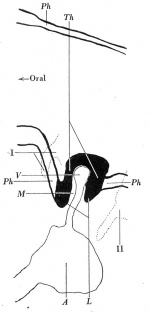
|
- Historic Papers: 22 Somites | 23 Somites | 25 Somites | 27 Somites | Brain Vascular System of the Human Embryo
Glossary Links
- Glossary: A | B | C | D | E | F | G | H | I | J | K | L | M | N | O | P | Q | R | S | T | U | V | W | X | Y | Z | Numbers | Symbols | Term Link
Cite this page: Hill, M.A. (2024, April 27) Embryology Carnegie stage 12. Retrieved from https://embryology.med.unsw.edu.au/embryology/index.php/Carnegie_stage_12
- © Dr Mark Hill 2024, UNSW Embryology ISBN: 978 0 7334 2609 4 - UNSW CRICOS Provider Code No. 00098G
